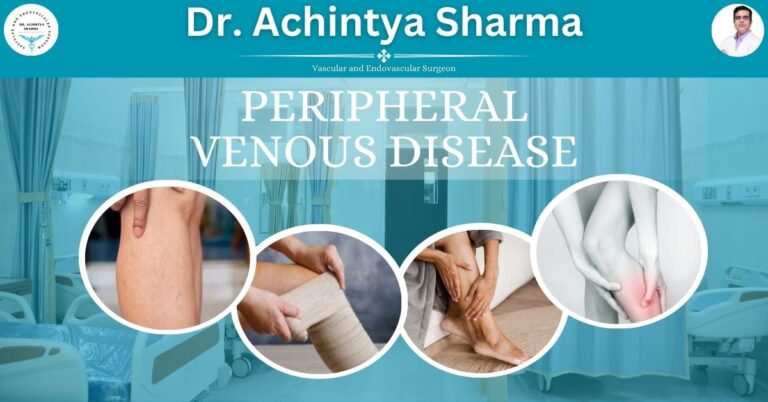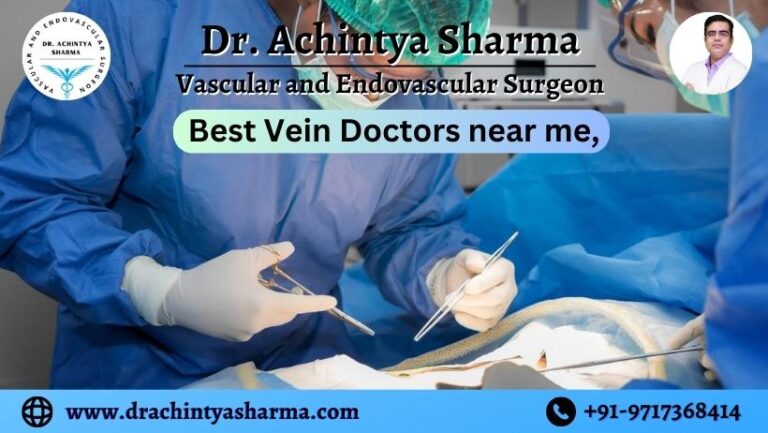Vein thrombosis is a serious yet often silent condition that affects millions around the world. It occurs when a blood clot forms inside a vein, blocking normal blood flow. If not treated in time, it can lead to severe complications, including pulmonary embolism — a life-threatening situation. Fortunately, awareness and early intervention can make a major difference. In this blog, we’ll simplify what venous thrombosis means, why it happens, how to recognise its warning signs, and what preventive steps you can take. Dr Achintya Sharma, a vascular specialist, will provide you with advice on how to safeguard the health of your veins before it is too late.
Why You Shouldn’t Ignore Vein Thrombosis
Most people assume leg pain or swelling is harmless, but sometimes, it’s your body’s cry for help. Vein thrombosis frequently appears subtly, particularly in the legs’ deep veins. When a clot blocks blood flow, it can trigger pain, redness, and swelling. If that clot travels to the lungs, it can cause a pulmonary embolism — a medical emergency. What makes this condition dangerous is its subtle nature. Without proper diagnosis, it may remain unnoticed until complications arise. That’s why understanding venous thrombosis isn’t just medical awareness; it’s a life-saving habit.
What Causes Vein Thrombosis?
Several factors can increase your risk of developing venous thrombosis.
- Prolonged sitting or immobility—long flights, office jobs, or bed rest reduce blood flow.
- Injury to veins — surgeries or accidents can damage the vessel walls.
- Medical conditions — cancer, obesity, and hormonal changes — can thicken the blood.
- Genetic predisposition — family history plays a key role.
- Age and lifestyle—As we age, our veins become less elastic, which facilitates the production of clots.
According to Dr Achintya Sharma, understanding these triggers helps individuals act early, adopt preventive habits, and seek timely medical evaluation.
Recognise the Symptoms Early
Spotting venous thrombosis early can prevent serious outcomes. Common symptoms include:
- Persistent pain or tenderness in the legs
- Unexplained swelling in one leg
- Skin warmth or redness around the affected area
- Heaviness or fatigue in the lower limbs
However, many cases remain symptom-free until the clot becomes large. This is where expert evaluation by a vascular specialist like Dr. Achintya Sharma becomes essential. Using ultrasound imaging and blood tests, he can confirm the presence of a clot and suggest the most effective treatment approach.
Treatment Options
Treatment depends on the clot’s size and location. Common approaches include:
- Blood-thinning medications to prevent clot growth
- Compression stockings to improve circulation
- Lifestyle modifications like regular movement and hydration
- Surgical procedures in severe cases to remove or dissolve the clot
With proper guidance from Dr Achintya Sharma, patients can recover safely and reduce future risks.

Prevent Vein Thrombosis Before It Starts
Prevention is always better than a cure. Here are simple steps to protect your veins:
- Move often—avoid sitting or standing for long hours.
- Stay hydrated—water keeps blood flow smooth.
- Exercise regularly—walking or leg stretches improve circulation.
- Maintain a healthy weight—reduces pressure on veins.
- Quit smoking—it damages vessel walls and thickens blood.
- Consult your doctor if you notice swelling, pain, or visible veins.
Dr Achintya Sharma emphasises that early screening and vascular check-ups can detect minor issues before they become dangerous. By maintaining healthy habits and staying informed, you can significantly lower your risk of veins thrombosis.
FAQs About Vein Thrombosis
1. What exactly is veins thrombosis?
Vein thrombosis is the formation of a blood clot inside a vein, usually in the legs. It obstructs normal blood flow and can become life-threatening if the clot travels to vital organs like the lungs.
2. What are the warning signs I should look for?
Swelling, redness, pain, and warmth in one leg are early indicators. Sudden shortness of breath or chest pain could suggest a clot has moved to the lungs—seek emergency care immediately.
3. Who is most at risk?
People who sit for long hours, are overweight, have undergone surgery, or have a family history of clots are more prone to developing vein thrombosis.
4. Can vein thrombosis be cured?
With timely treatment, most patients recover fully. Medications and lifestyle changes can stop clots from growing and prevent new ones from forming.
5. How can I prevent it naturally?
Stay active, eat balanced meals, drink plenty of water, and avoid long periods of inactivity. Regular vascular health check-ups with Dr Achintya Sharma are also recommended.
Conclusion
Vein thrombosis is not merely a minor circulation problem; it is a quiet danger that can suddenly become life-threatening. The good news is that prevention and early treatment are highly effective. Understanding your body, noticing subtle symptoms, and seeking expert advice can make all the difference. Healthy veins depend on sustaining active circulation, drinking enough water, and scheduling routine checkups with the doctor, as Dr Achintya Sharma explains. Don’t wait for warning signs — protect your vascular health today. You can actually stop the clot before it stops you with awareness and prompt care.




